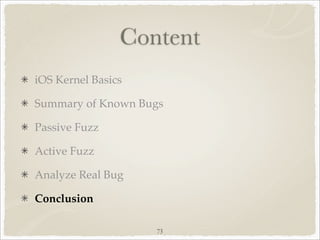Find your own iOS kernel bug
- 1. Find Your Own iOS Kernel Bug Chen Xiaobo & Xu Hao 1
- 2. Content iOS Kernel Basics Summary of Known Bugs Passive Fuzz Active Fuzz Analyze Real Bug Conclusion 2
- 3. iOS Kernel Basics OSX is older that iOS Guess iOS kernel is developed based on OSX kernel Learn from OSX kernel OSX kernel concepts Early derived from FreeBSD kernel Named as XNU Open source 3
- 4. XNU Open Source http://www.opensource.apple.com/source/xnu/ xnu-2050.7.9/ Important components Mach - Low level abstraction of kernel BSD - High level abstraction of kernel IOKit - Apple kernel extension framework 4
- 5. BSD Implement File System, Socket and ... Export POSIX API Basic interface between kernel and user space sysent[] - store kernel function address typedef int32_t sy_call_t(struct proc *, void *, int *); function call number - /usr/include/sys/syscall.h 5
- 6. IOKit Framework for kernel extension Subset of C++ - Object-Oriented driver programming 6
- 7. IOKit Objects OSObject Root object of all IOKit objects Overwrite new operator to alloc memory Declare “init” method to initialize object self OSMetaClass Run-time object type check According to object name OSDynamicCast 7
- 8. IOKit Objects IOService Define an interface for most kernel extension Basic methods - init / start / stop / attach / detach / probe ioreg - list all attached IOService Available in Cydia 8
- 9. Write IOKit Service - Inherit from IOService Overwrite basic methods - init / start / stop / probe Control - Inherit from IOUserClient Allow user space control Modify plist file At least one IOKitPersonalities CFBundleIdentifier/IOClass/IOProviderClass/IOMatchCategory/ IOUserClientClass/IOResourceMatch 9
- 10. Kernelcache Store all kernel modules (XNU / extensions) into one cache file iBoot will load the whole kernelcache and jump to entry An encrypted and packed IMG3 file /System/Library/Caches/com.apple.kernelcaches/kernelcache For old devices (A4 devices) Use xpwntool to decrypt original cache with IV + KEY A5 devices No IV + KEY available 10
- 11. Kernelcache How to get kernelcache for A5 devices Dump from kernel memory task_for_pid(0) & vm_read to dump kernel memory Read size must less then 0x1000 for once Find all Mach-O header - test magic 0xFEEDFACE Determine the whole cache size Open with IDA - fail Lack of prelink info 11
- 12. Kernelcache Dump each kernel extension Write a kextstat for iOS Just call CFDictionaryRef OSKextCopyLoadedKextInfo(CFArrayRef, CFArrayRef) from IOKit framework 12
- 13. Reverse Kernel Kernelcache is combined with lots of Mach-O files IDA Pro 6.2 could identify each Mach-O file Reverse the whole kernel together Open “Segmentation” view 13
- 14. Reverse IOKit Extension IOKit constructor example First call OSObject::new to allocate memory Then init IOService At last init OSMetaClass 14
- 15. Debug iOS Kernel KDP code is included in kernel KDP via UART SerialKDPProxy to perform proxy between serial and UDP Need serial communicate between USB and Dock connector Make a cable by your own Using redsn0w to set boot-args -a “-v debug=0x09” 15
- 16. Debug iOS Kernel A5 CPU Devices No limera1n vulnerability - no way to set boot-arg Need a kernel exploit to cheat kernel with boot-arg & debug enable See “iOS5 An Exploitation Nightmare” from Stefan Esser for details 16
- 17. Content iOS Kernel Basics Summary of Known Bugs Passive Fuzz Active Fuzz Analyze Real Bug Conclusion 17
- 18. Summary of Known Bugs iOS kernel attack surface Socket/Syscalls ioctl FileSystem drivers HFS iOKit Device drivers (USB/Baseband etc) 18
- 19. CVE-2010-2973 CVE-2010-2973 - IOSurfaceRoot integer overflow Used in the jailbreakme 2 as PE exploit Can be triggered by mobile user apps (MobileSafari) Malformed IOSurfaceAllocSize/IOSurfaceBytesPerRow/ IOSurfaceHeight/IOSurfaceWidth values in the plist Create a Surface object using above plist and return a userland ptr Calling memcpy to overflow the important kernel structure to disable the security protection 19
- 20. CVE-2010-2973 CVE-2010-2973 - IOSurfaceRoot integer overflow The plist Exploit: https://github.com/comex/star/blob/master/goo/zero.py 20
- 21. CVE-2011-0227 CVE-2011-0227 - IOMobileFrameBuffer Type Conversion Issue RootCause happens in the IOMobileFrameBuffer are not properly to check the object when doing conversion Suppose to call OSDynamicCast() while doing type casting/conversion The user able to control the vtable function pointer to get code execution 21
- 22. CVE-2011-0227 CVE-2011-0227 - IOMobileFrameBuffer Type Conversion Issue PoC: Fully exploit: https://github.com/comex/star_/blob/master/ catalog/catalog.py 22
- 23. Summary of Known Bugs Conclusion They are both PE vulns because it is happens in the IOKit drivers framework Closed source and less people pay attention Good target for bug hunting! 23
- 24. Content iOS Kernel Basics Summary of Known Bugs Passive Fuzz Active Fuzz Analyze Real Bug Conclusion 24
- 25. Passive Fuzz Passive Fuzz First idea coming out is fuzzing Less work with good results Write a IOKit client to understand how the IOKit works Fuzzing parameters for IOConnectCallStructMethod/ IOConnectCallScalarMethod In the low-level both above APIs are calling to the IOConnectCallMethod 25
- 26. Passive Fuzz Why we need passive fuzzing? They key point is pay less works because we are lazy to audit code :P Just like hook DeviceIoControl on the win32 to hunting kernel bugs We are going to hook IOConnectCallMethod to do the passive fuzzing 26
- 27. Passive Fuzz The Preparation Finding a good hook framework for iOS MobileSubstrate http://iphonedevwiki.net/index.php/MobileSubstrate MSHookFunction/MSHookMessage for C/Object Method hook Not much documents but enough to make it work 27
- 28. Passive Fuzz TheOS/Tweak Base the mobilesubstrate but more user-friendly https://github.com/DHowett/theos 28
- 29. Passive Fuzz You can also using interpose (dyld function) Redirect the functions in the import table No libmobilesubstrate required. Inject your dylib via DYLD_INSERT_LIBRARIES to make your fuzzer running! 29
- 30. Passive Fuzz Tips Struct object could be Data/Plist(XML), So pay some work here. Scalar object are integer values only, random enough to find some interesting stuffs. Results: NULL pointer deference/Kernel Use-after-free/handled panic exception 30
- 31. Content iOS Kernel Basics Summary of Known Bugs Passive Fuzz Active Fuzz Analyze Real Bug Conclusion 31
- 32. Active Fuzz Weakness of passive fuzz Only cover small amount of IOKit interfaces Needs interaction - keep using your iPhone Not so efficient - waste time Advantage of active fuzz Cover most of IOKit interfaces Automatically and efficient 32
- 33. Rough Idea Find all IOKit drivers with IOUserClient Identify all external methods of the driver Test all those methods 33
- 34. External Methods External methods are used by IOKit to provide function to user- space application Application call IOConnectCallMethod to control driver selector - which method should be called input / output - Array of uint64_t or struct data 34
- 35. Kernel Dispatch IOConnectCallMethod -> IOUserClient:: externalMethod if dispatch != NULL Check input and output size & call dispatch->function else call getTargetAndMethodForIndex Check type and size & call method->func 35
- 36. IOKit Implement Overwrite externalMethod Example 36
- 37. IOKit Implement 37
- 38. IOKit Implement Overwrite getTargetAndMethodForIndex Example 38
- 39. Key Point Know what to fuzz Get IOExternalMethodDispatch sMethods[] Get IOExternalMethod methodTemplate[] 39
- 40. How For the IOKit drivers without source code Reverse the KernelCache with symbol problem resolved IOKit structure you should know IOExternalMethodDispatch & IOExternalMethod Filter the IOKit keywords in the IDA name window sMethods etc. Will list all the IOKit drivers interface 40
- 41. sMethods We have the interface names & address 41
- 42. sMethods But there are just bytes in the method dispatch table IDA pro currently not handle it properly 42
- 43. sMethods After some manually work (Mark to the DCD) We can see some function pointers, but still ugly 43
- 44. Work Todo Need some IDA Python works here Add IOKit struct information in the idb file (IOExternalMethodDispatch & IOExternalMethod) Find the dispatch table range and mark it to the correct struct. 44
- 45. Result Looks better now We have dispatch function, flag, input/output count. 45
- 46. Correct Input Flags defines I = input O = output For example, type 3 means: Struct input & output We must pass the correct input/output type and count, otherwise the request will be rejected Start coding your own actively fuzzer! 46
- 47. Extra You can also add the vtable information if you like to audit code Before After 47
- 48. Content iOS Kernel Basics Summary of Known Bugs Passive Fuzz Active Fuzz Analyze Real Bug Conclusion 48
- 49. Are There Bugs? Definitely YES Crashes could be easily generated by our fuzzer Actually kernel code of iOS is not as good as you imagine However analyzing crash is a hard job No code or symbols for most IOKit drivers Kernel debug is kinda of crap Any exploitable bug? This is a QUESTION 49
- 50. IOKit Bug Analysis Simplify crash code Code is generated by fuzzer - there are many IOConnectCallMethod calls Simplify the code could help you a lot when doing static analysis Look at panic log fault_type & register values Static analysis Understand the bug and trigger path Debug Write exploit 50
- 51. Bug Sample I Let’s look at the code first 51
- 52. Bug Sample I Then the panic log PC = 0x80455c3c fault_addr = 0x0 52
- 53. Bug Sample I Where did it crash Try to read data at R1(=0) cause the panic R1 is the second parameter of this function It is mostly like a NULL ptr reference bug :( We shall dig deeper anyway 53
- 54. Bug Sample I Locate sMethod array First to find AppleVXD375UserClient::externalMethod, which should overwrite IOUserClient’s method IOUserClient has symbols, see vtable for it externalMethod pointer offset in vtable 54
- 55. Bug Sample I Locate sMethod array Search IOUserClient::registerNotificationPort address in “const” segment Find externalMethod pointer in vtable for AppleVXD375UserClient AppleVXD375UserClient::externalMethod Get IOExternalMethodDispatch struct from sMethod array Call IOUserClient::externalMethod to dispatch it 55
- 56. Bug Sample I sMethod = 0x80469700 56
- 57. Bug Sample I selector = 1 dispatch struct in sMethod function address = 0x80457534 checkStructureInputSize = 0x4 checkStructureOutputSize = 0x108 Remember the trigger code? 57
- 58. Bug Sample I The whole call path externalMethod -> sub_ 80457534 -> sub_ 804577EC -> sub_8045779C -> sub_80456768 -> sub_80455C34 -> panic sub_ 804577EC call OSObject::release first This method should be used to destroy AppleVXD375UserClient itself sub_8045779C should be responsible for freeing memory R1(=0) maybe some class or struct address stored in AppleVXD375UserClient object 58
- 59. Bug Sample I Understand this bug We manually try to destroy AppleVXD375UserClient When in procedure, it will manipulate some object without checking if it is already created Lacks of basic check code like if (obj->ptr != NULL) We are not able to control PC register 59
- 60. Bug Sample II Code first 60
- 61. Bug Sample II Panic log PC = 0x00000000 Looks better than last one 61
- 62. Bug Sample II Where did it crash We got useless PC and no call stack But luckily we had LR - store return address Looks like calling method of certain object R4 - object pointer R0 - vtable 62
- 63. Bug Sample II Crash code snapshot 63
- 64. Bug Sample II Crash code analysis Input R0 - IOAccelUserClient *self R1 - int index IOAccel *service = self + 0x78 OSObject *array[] = service + 0x10 Call array[index]->method = NULL 64
- 65. Bug Sample II Weird Why the object’s method pointer is NULL Guess Mistake it as a different object without checking Todo Figure out what’s at 0x10 offset 65
- 66. Bug Sample II Locate external methods This time it overwrite getTargetAndMethodForIndex 66
- 67. Bug Sample II IOExternalMethod methodTemplate[5] 67
- 68. Bug Sample II Where is selector 6 function ? Check reference to IOAccelUserClient::vtable It has a child object - IOIMGSGXUserClient Easy to find getTargetAndMethodForIndex again 68
- 69. Bug Sample II When selector > 5, use its own methodTemplate[3] 69
- 70. Bug Sample II What’s at offset 0x10 ? Look inside into selector 6 function 70
- 71. Bug Sample II Object is created, check vtable 0x8090E5B8 0x8090E5B8+0x3C = 0x8090E5F4 71
- 72. Bug Sample II Here is the story selector 6 function call sub_80907A4C to create an object and put it in object array at 0x10 offset selector 3 function get object pointer from the array and call its method without checking its class type Actually the child has its own create/destroy method. If the child create an object and make father to destroy it, PANIC ! Apple should call more OSMetaClassBase::safeMetaCast :P 72
- 73. Content iOS Kernel Basics Summary of Known Bugs Passive Fuzz Active Fuzz Analyze Real Bug Conclusion 73
- 74. Conclusion Apple should audit iOS kernel code, especially code of IOKit extensions Since debug is quite hard, static analysis according to panic log is very helpful Fuzz your own iOS kernel bug ! 74

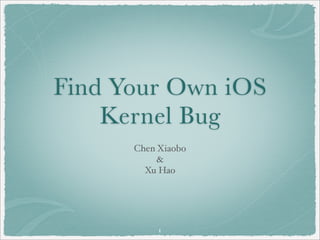
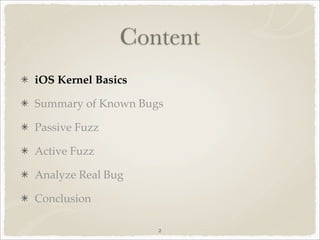
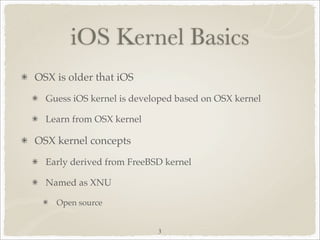

![BSD
Implement File System, Socket and ...
Export POSIX API
Basic interface between kernel and user space
sysent[] - store kernel function address
typedef int32_t sy_call_t(struct proc *, void *, int *);
function call number - /usr/include/sys/syscall.h
5](https://image.slidesharecdn.com/findyourownioskernelbug-121117181123-phpapp02/85/Find-your-own-iOS-kernel-bug-5-320.jpg)


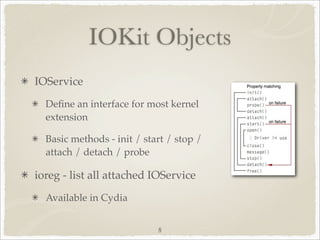
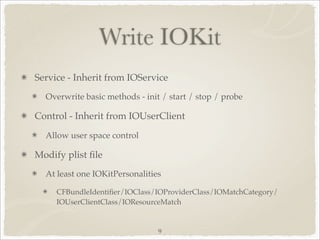
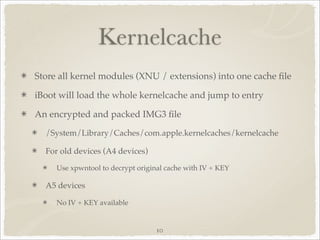
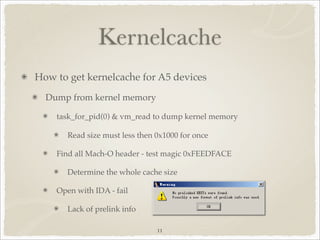

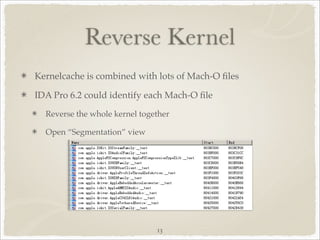
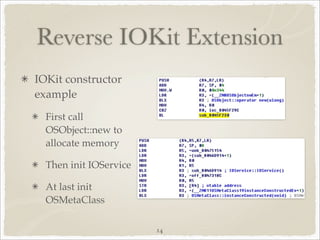

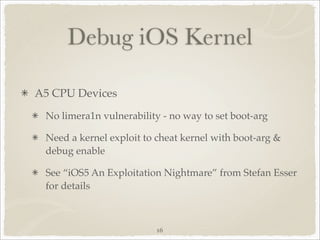
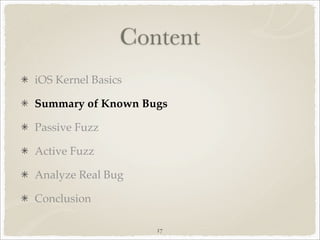
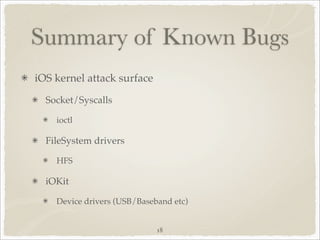
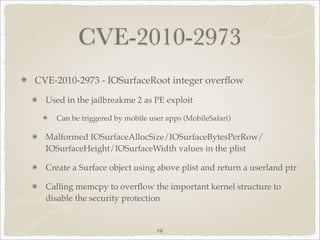
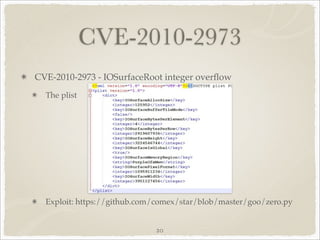
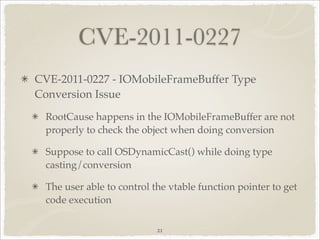
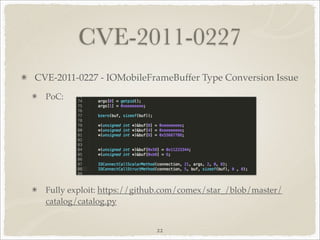
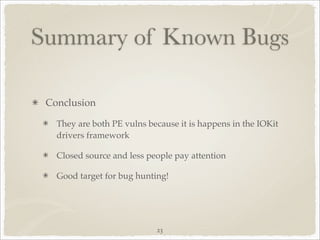


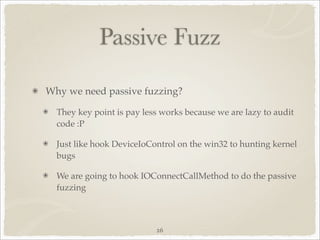
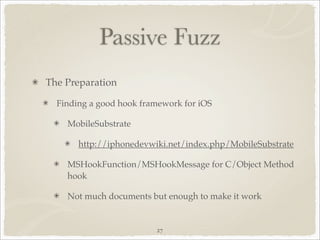

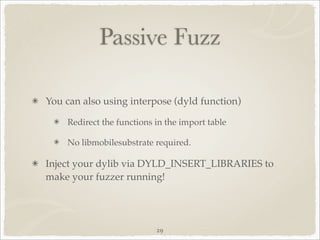
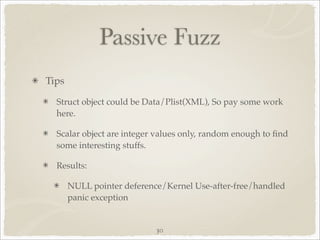
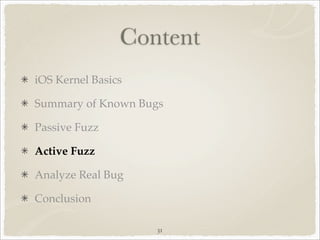
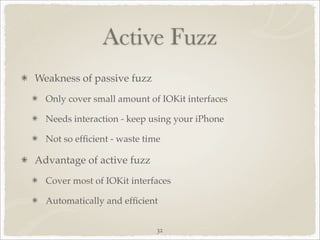
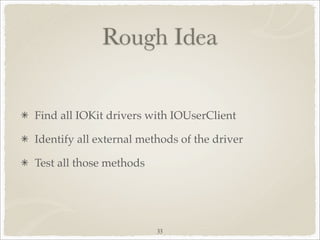

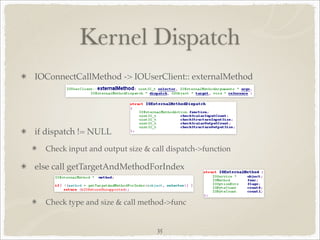
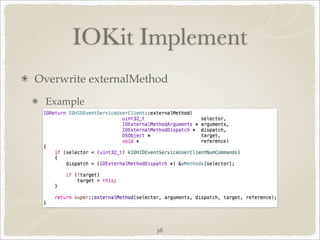

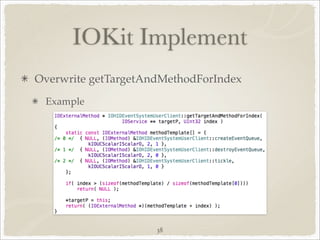
![Key Point
Know what to fuzz
Get IOExternalMethodDispatch sMethods[]
Get IOExternalMethod methodTemplate[]
39](https://image.slidesharecdn.com/findyourownioskernelbug-121117181123-phpapp02/85/Find-your-own-iOS-kernel-bug-39-320.jpg)
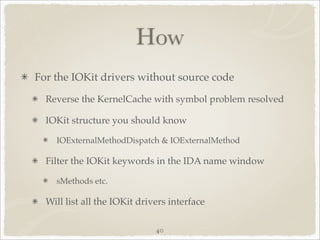
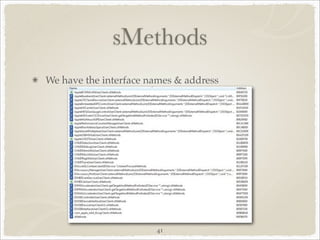

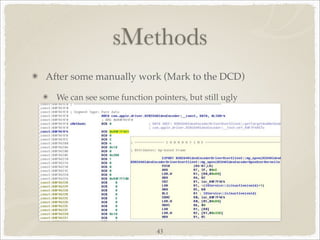


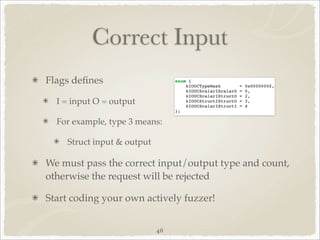



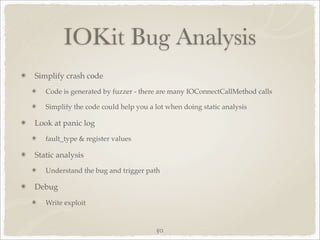



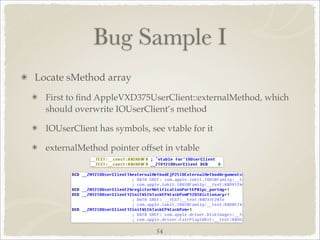


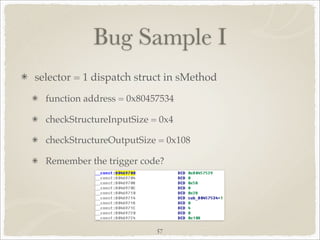
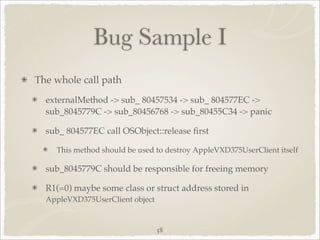
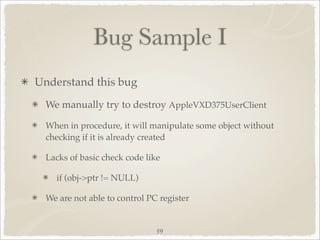
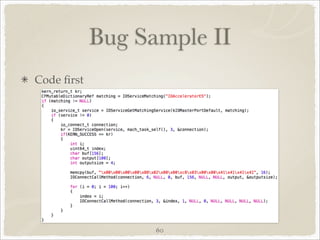
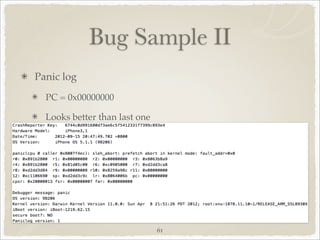
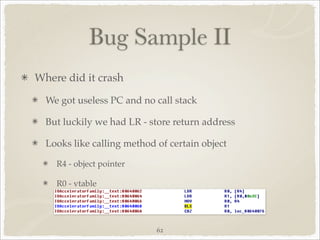
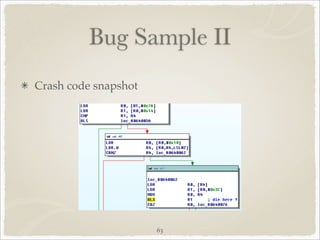
![Bug Sample II
Crash code analysis
Input
R0 - IOAccelUserClient *self
R1 - int index
IOAccel *service = self + 0x78
OSObject *array[] = service + 0x10
Call array[index]->method = NULL
64](https://image.slidesharecdn.com/findyourownioskernelbug-121117181123-phpapp02/85/Find-your-own-iOS-kernel-bug-64-320.jpg)
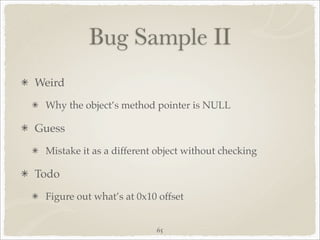
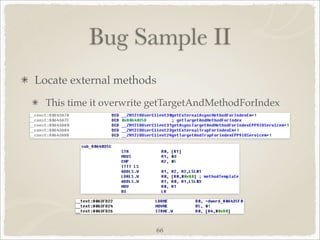
![Bug Sample II
IOExternalMethod methodTemplate[5]
67](https://image.slidesharecdn.com/findyourownioskernelbug-121117181123-phpapp02/85/Find-your-own-iOS-kernel-bug-67-320.jpg)

![Bug Sample II
When selector > 5, use its own methodTemplate[3]
69](https://image.slidesharecdn.com/findyourownioskernelbug-121117181123-phpapp02/85/Find-your-own-iOS-kernel-bug-69-320.jpg)



